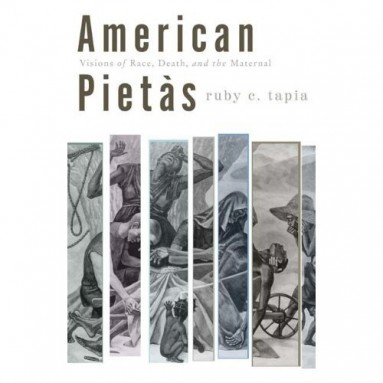On the Casey Anthony Trial and Ruby C. Tapia’s American Pietàs: Visions of Race, Death, and the Maternal
Several weeks ago, I caught my first glimpse of the public spectacle that is the Casey Anthony murder trial, playing simultaneously on two televisions, volume on, at my doctor’s office. Commentators wondered aloud if Casey would get the death penalty, if she were pure evil or just an unfit mother, if Casey’s brother was her dead child’s father. It is hard not to get sucked in by the trial—since her two-year-old daughter Caylee’s 2008 disappearance and her eventual arrest, Casey has graced countless magazine covers and has been the subject of minute to minute updates covered by major networks and obsessed bloggers alike. Casey’s acquittal on murder charges led to a million status updates, tweets, and plenty of inter-cubicle shouting. A cursory web search comes up with dozens of collections of “evidence” photos, including the contents of Casey’s cell phone, Facebook, Myspace, and Photobucket. The debris of her life is on display and up for judgment—not only by a jury of peers, but the entire nation. Evidence against Casey includes photographs of her having fun while Caylee was missing—shopping, dancing, drinking with friends, entering a hot body contest at a club. The investigation, the trial, and Casey Anthony are a hot mess, and it’s all online and available for your consumption.
In Ruby C.Tapia’s American Pietàs: Visions of Race, Death, and the Maternal, the Pietà functions as an entry point from which to investigate national identity and the biopolitical processes through which U.S. citizens and maternal subjects are reproduced, particularly through photographic media. Tapia conjures ghosts, haunting figures, and vanished presences, recalls histories of racialized motherhood sloughed away in the sculpting of the Pietà of American nationalism—the universalized white maternal which reproduces the nation-state. The Pietàby Michelangelo is an iconic image of maternal suffering—the Virgin Mary cut from white marble, cradling the gaunt body of her crucified son. Her face is somber but serene—she mourns, and draws the viewer into her mourning, but also serves to reassure the viewer of the certainty of resurrection. This image of Mary holds universal appeal beyond its religious content because of the maternal context, a mother with her dead child. But the trials of Casey Anthony streamed live indicate a different strain of American attention: We are at least equally compelled by the monstrous mother and the frozen image of her dark Pietà.
In her introduction, Tapia draws parallels between Michelangelo’s statue and a 2001 photograph of Father Mychal Judge, which has been labeled “The American Pietà.” The photograph of Judge, the first documented victim of the September 11 attacks, being removed from the World Trade Center Tower by firefighters does evoke the themes of the Pietà. Judge’s prone, lifeless body, coated in white dust and already sanctified through his Catholic vows, is carried by five white, masculine firefighters recast as Mary through the emotional presence of the stoic maternal nation. America mourns her fallen heroes and gestures toward the nation’s collective resurrection. In the historical context of September 11, the national salvation implicit in the American Pietà can only be through war and invasion, attaching the portrait and abstraction of maternal grief to a neo-imperialist military project. Despite arguing for the American Pietà as an understudied U.S. visual culture, Tapia deals only briefly with other so-called American Pietàs, such as the 1995 image of infant Oklahoma City bombing victim Baylee Almon cradled by firefighter Chris Fields or the 2005 photograph of Katrina victim Edgar Hollingsworth being removed from his home by paramedics. The Pietà rather functions as an entry point from which to analyze other images that represent similar themes as generative ruptures, interrogating the nationalist project of citizen-making through presence and erasure, actual and social death.
Tapia engages in a practice of visual studies guided by Roland Barthes’ Camera Lucida: Reflections on Photography—the focus of her first chapter. Barthes’punctum—the thing in a photograph which pierces, affectively draws in the viewer—is instructive to Tapia’s reading. American Pietàs engages a disparate range of maternal images within the framework of U.S. visual nationalism, following an emotive path between the images. American Pietàs considers images that are, at first glance, unconnected within a broad universe of ephemeral media—photographs of September 11 victims and widows, popular commemorative magazine images of Princess Diana and Mother Teresa, Oprah’s Beloved, teen pregnancy advertisements, and 19th century postmortem photography. By the end of the book, Tapia successfully maps how each image influences how the others are viewed, leading towards a cohesive argument: “Seemingly isolated representations garner the power to persuade and to move viewers toward more (or less) feeling when they work to reinforce one another.” The argument is beautifully, even poetically constructed, and most politically relevant in its last two chapters, in which Tapia contrasts the images of “cherished pregnant widows” and “ruined pregnant teens” in a nationalist project of citizen reproduction.
Through the pro-abstinence advertising of California’s Partnership for Responsible Parenting teen pregnancy campaign, invariably-brown teenage parents and their offspring are assumed to be an alien drain on national resources—non-citizens regardless of immigration status because they are not white, not married, not appropriate consumers or appropriately consumable. In contrast, a 2002 People Weekly cover, featuring 31 September 11 widows and their infants, projects a uniform heterosexual whiteness over the women in the photograph, as well as over the nation itself, through the white-clad babies they hold. Unlike the threatening, invasive infants of the teen pregnancy advertisements, People’s multiple (and visually multiplying) white babies promise collective national recovery after the rupture of the September 11 attacks. It is only when September 11 widows themselves become a threat to the unified national image—as in the case of the “Jersey Girls” of the 9/11 Family Steering Committee—that images of children disappear. These widows are then visually constructed as aberrant through their apparent childlessness—they cease to be “the grieving mothers of the Pietà” and become “attention whores.”
Tapia’s project evokes Benedict Anderson’s Imagined Communities, the concept of nationalist affinity we hold through shared interest and identity as constructed through media. But since that volume’s publication in 1983, social networking sites, blogs, even reality television have disseminated images of the maternal that go far beyond the realm of Anderson’s imagination. Digital images multiply and go viral, and we click through hundreds of Facebook pictures or blog links in a sitting, creating vast visual lexicons that go far beyond the subjects of Tapia’s scrutiny. I suspect the popular figuring of the maternal is increasingly defined less by Princess Diana and more by 16 and Pregnant and the terrifying stage moms ofToddlers & Tiaras. In contrast to Tapia’s non-citizen teenage mothers, the brown pregnant teens of 16 and Pregnant fade away into the all-white, significantly middle class cast of the Teen Mom franchise. While teen pregnancy is stereotyped as a racialized epidemic of burgeoning inner-city welfare queens in public service and political campaigns, the airwaves are increasingly flooded with teen moms in the model of The Secret Life of the American Teenager character Amy Juergens—the nice, middle class white girl who made a mistake, but who will not present a burden to taxpayers. The exclusion of the most demonized mothers—young black and Latina women—from this flood of “bad moms” in popular culture lets us enact our sordid fantasies without requiring the targeted white audience to think about race at all.
There is no doubt that we are a culture obsessed with (so-called) bad mothers; saintly dead moms (like Princess Di) don’t have the same sordid appeal as living mothers with dead children. It is especially difficult to resist bad mothers, and harder still bad mothers clutching their children’s murdered bodies. American Pietàs argues that rather than being universal, motherhood is always figured within a necropolitical, racializing logic that constructs the appropriately maternal as white, as is the nation it reproduces and resurrects. But it is the rupture of this logic, the contradictory figure of the killer white mom that attracts us like flies to the dark Pietà of Casey Anthony. The Pietà cast over grieving September 11 widows, the memory of their dead husbands superimposed onto their fatherless newborns, does not neatly fit over the nationally imagined vision of Anthony holding duct tape over her two-year-old’s mouth, and yet it is a Pietà all the same, a more appropriate one for contemporary America. Anthony’s face devoid of grief gestures toward processes of unbecoming, destruction, and refusal rather than resurrection or collective salvation.

